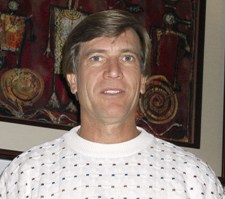David Overskei, PhD '76
He sounds a lot like Fred Rogers – as in Mr. Rogers’ Neighborhood. His voice is mellifluous and folksy, his cadence slow and thoughtful. It comes as no surprise that he grew up on a farm in South Dakota. The disconnect happens when he talks about fusion research, strategic management, technology ventures, information management software, and nuclear weapons.

Unlike Mr. Rogers, David Overskei has expertise in all those areas. He began as a fusion researcher at MIT and went on to senior management positions at General Atomics and Science Applications International Corporation, where Overskei’s wife, Katherine, MG ‘80, serves as vice president of human resources. He was also president and CEO of Polexis, a data-integration software company, before forming Decision Factors, his consulting firm in San Diego.
Since January 2005, Overskei has chaired the Nuclear Weapons Complex Infrastructure Task Force for the U.S. Department of Energy. The committee of six experts was commissioned by Secretary of Energy Samuel Bodman, ScD ‘65, to assess the state of the American nuclear weapons complex, comprised of eight facilities around the U.S. Their report, released last July, critiques the aging complex and recommends constructing one new facility to manufacture and refurbish bombs; moving the nation’s supply of plutonium and weapons-grade uranium to that facility; and developing new, more-reliable and secure bombs.
“We believe that over the foreseeable future – if the government does these things – we could get down to only hundreds of nuclear weapons, not thousands,” Overskei says. That could be achieved by 2030 or sooner, he believes. Overskei is pleased that even representatives from facilities that might suffer losses have commented on the accuracy of the report.
Now that the task force work is winding down, Overskei is working on one of his latest ventures: developing software for data sharing among fire, police, EMTs, and other local, state, and federal agencies. It’s a quantum leap from the voice technology currently in use because the software allows visual data like maps or images to be shared. Overskei installed the software in Livermore and Pleasanton, CA, in December and is collecting data on how it is working. “This is a big breakthrough for public safety organizations,” he says. Looks like the neighborhood just got better.
Keep Reading
Most Popular
Large language models can do jaw-dropping things. But nobody knows exactly why.
And that's a problem. Figuring it out is one of the biggest scientific puzzles of our time and a crucial step towards controlling more powerful future models.
The problem with plug-in hybrids? Their drivers.
Plug-in hybrids are often sold as a transition to EVs, but new data from Europe shows we’re still underestimating the emissions they produce.
How scientists traced a mysterious covid case back to six toilets
When wastewater surveillance turns into a hunt for a single infected individual, the ethics get tricky.
Google DeepMind’s new generative model makes Super Mario–like games from scratch
Genie learns how to control games by watching hours and hours of video. It could help train next-gen robots too.
Stay connected
Get the latest updates from
MIT Technology Review
Discover special offers, top stories, upcoming events, and more.